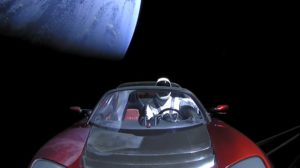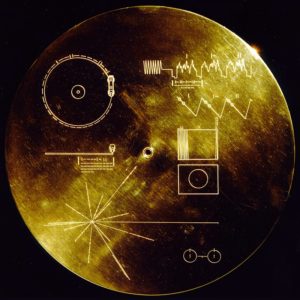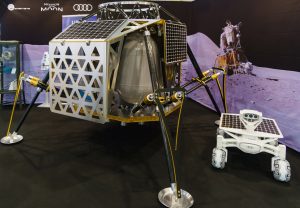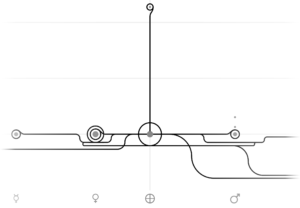When PTScientists’ ALINA spacecraft blasts off into space next year, it will be carrying some precious cargo from Earth from a project known as Sanctuary, a time capsule of information that reflects humanity as it is today. In this exclusive article, Benoit Faiveley, Producer and Engineer at Sanctuary, explains the reasons why we must turn to space to ensure that humanity on Earth is remembered. This is the archaeology of the future.
Highway to space

In February 2018, millions of people watched the maiden flight of Falcon Heavy and its unusual payload: a cherry red Tesla roadster. Behind the wheel was “Starman”, a mannequin clad in a space suit. Multiple cameras on the vehicle captured the ride, as David Bowie’s Space Oddity was played during the launch. Humorous, geeky, and emotive.
The roadster belonged to Elon Musk, the founder of SpaceX. He sent it because he liked “the thought of a car drifting apparently endlessly through space and perhaps being discovered by an alien race millions of years in the future.” But doesn’t even this “endlessly” have an end?
On Earth, natural forces such as wind, rain and earthquakes have weathered down buildings, monuments and the daily evidence of civilization such as tools, clothing and personal items. Historical artefacts like the Pyramids are standing, but we will never know about all the things that aren’t.
Realistically, it’s not just our creations, but also their creators – the inventive engineers, Homo sapiens, who all have a limited time span on Earth. What will remain of the things we make and of us in the future?
The idea of protecting the things we make from the ravages of time is a recent phenomenon. For example, it was not until 1978 that the Pyramids were added to the UNESCO World Heritage List, along with other sites such as the Colosseum and the Lascaux cave. But despite our best efforts, anything on Earth is subject to the same forces that shaped the planet itself. We may be able to mitigate the effects of time, but this is an active process. As we disappear, so will everything that we guarded.
But now space exploration has opened a door to a potentially eternal safe room. We can protect objects forever by freezing them in time—in the permanent and indelible vault of space. This vault already contains some objects, such as the spacecraft already sent into and out of the solar system.
Space: an eternal vault

In 1977, everyone at NASA’s Cape Canaveral was holding their breath. The interplanetary probe Voyager 2 was on the launchpad and, in seconds, it would begin its long journey for fly-bys of the largest planets in the solar system: Jupiter, Saturn, Uranus, and Neptune. Voyager 1, Voyager 2’s twin sister, would launch in September of the same year.
Less than forty years after their launches, these two probes changed status, from “interplanetary” probes to “interstellar” probes. Today, both spacecraft are receding into the vastness of space. Next stop: the star Ross 248, which Voyager 2 will reach in 40,000 years.
Before the launch, the astrophysicist Carl Sagan suggested including a time capsule on these spacecraft. And thus, the idea of the “Golden Record” was born—a portrait of Humanity in the form of a modern version of a 16.5 rpm vinyl.
The record would store a few minutes of audio recording sounds from the Earth, music, and greetings in 55 languages, as well as a selection of many drawings and illustrations, and photographs. There were photographs of male and female gametes, conception of a child, a woman breastfeeding, the structure of DNA, a fisherman and his net, an airplane taking off, a diver exploring the underwater world. A scientific Rosetta stone was also included.
In the documentary “The Farthest”, the record is identified as the real “heartbeat of the spacecraft”. This heart is likely to be eternal—the life expectancy of the Golden Record is thought to be in the billions of years. It is deep frozen in time.
Carl Sagan recognized that alongside the literal message of the Golden Record—one that might not even be intelligible to anyone that finds the record—there are many implied ones. He said “The Voyager is itself a message. In their exploratory intent, in the lofty ambition of their objectives, in their utter lack to do harm, and in the brilliance of their design and performance, these robots speak eloquently for us.”
Moon: our backyard vault

2019 will mark the 50th anniversary of the first human step on another world: the Moon. In commemoration, PTScientists, an engineering team based in Germany, will launch their spacecraft ALINA to explore where we last stepped on the Moon. ALINA will carry a pair of rovers that will explore the area of Taurus-Littrow, where Apollo 17’s Lunar Roving Vehicle (LRV) still sits.
It will be the first mission of its kind: a space exploration that is in part dedicated to archaeology. This will be an unusual archaeological exploration, though, since we know exactly what will be found. Ten years ago, the Lunar Reconnaissance Orbiter (LRO) sent close-up pictures of the six Apollo landing sites, from the iconic Apollo 11 Tranquility base to the Apollo 17 plains of Taurus-Littrow. On the pictures sent back to Earth, astronaut bootprints and LRV tracks are still visible, as are descent stages and lunar experimental equipment. The American flags are still casting their shadow on the lunar soil.
Some may ask why we would wish to visit the Apollo landing site after 47 years. Cui bono? After all, won’t the landing site equipment remain frozen in time for the next 100 or 1,000 or even 100,000 years? Not exactly.
Pigments don’t do well in the sunlight: the American flags are likely to have faded out. In 1972, the LRV was also originally conceived with materials never intended to stay in space: there were velcro seatbelts and wheels made of piano wires. Duct tape was used to repair a fender Gene Cernan, the last man to have walked on the Moon, accidentally broke during an EVA. How have these different materials aged in space? Ironically, Elon Musk takes pride in having the least space-qualified artefact too. His roadster, made of batteries, a plastic dashboard and fabric covered seats was never intended to age in space.
But exploring the Apollo sites will require care. Although there is no legal precedent of what is to be done with the material left on the Moon by the crew of Apollo 17, NASA has issued guidelines to protect these historic landmarks. And just like for the Chauvet cave, an organization (For All Moonkind) is pushing for an international recognition of the Apollo sites as aspects of Human Heritage. PTScientists will not be permitted to disturb the site and be required to land outside the exclusion zone, a 2 km radius around the Apollo site. The rovers will be remote archaeologists and will be allowed to watch, but not touch.
One highlight of the PTScientists mission will be their twin rovers’ approach of the LRV. A couple of metres away from the front wheel, Gene Cernan scribbled his daughter’s initials in the dust: TDC (Teresa “Tracy” Dawn Cernan). The rovers’ first archaeological find might be this beautiful gesture of a father for his daughter, who was 9 at the time.
A new deposit in the vault

ALINA will also carry Sanctuary, a 700 gram collection of fine-etched sapphire discs on which our group has been working since January 2017.
What will appear on the discs? Choosing the content was a great challenge. Although no group can speak on behalf of humanity, as a group of humans we can speak with humanity. Our goal is to strike a balance between the fundamental (e.g. genomes of a man and a woman), the sublime (e.g. art work) and the social (e.g. collaborative creations). The discs will last for millennia: a long time to reflect on our choices. Whatever we do choose will be part of an ongoing conversation with ourselves, space and the future. What would you choose?
Sanctuary will safeguard aspects of ourselves, our culture and individual expression on another world. The human genomes will be our first attempt at an off-site backup of ourselves—let’s hope that no reboot will be necessary.
A possible scenario
In the far-off future, all memories of Apollo missions are gone. New Lunar explorers notice unusual marks on the surface. Like Jean-Marie Chauvet and his team in 1994, they dispatch archaeologists who find the tracks of PTScientists rovers on top of the thinner tracks of the Apollo LRV – proof of an exploration of another exploration. On ALINA, they find the discs of Sanctuary and, like Champollion, they begin to decipher, interpret and imagine.
When creating Sanctuary, we recognized that there is value in the inherent mystery of the discs. We are asking future explorers to step back in time and join us in our exploration of ourselves, our world and our epoch.

Benoit Faiveley studied engineering… and journalism. He worked for various media outlets such as Al Jazeera English, Arte, RTS, BBC. For the last two years he has been working as a producer on the Sanctuary project. Sanctuary will board ALINA for Mission to the Moon in 2019 in the first privately funded mission dedicated to archaeology on another world.
The Sanctuary Team
- Benoit Faiveley
- Nathalie Besson
- Mario C.E Freese
- Martin Krzywinski
- Roland Lehoucq
- Emmanuel Pietriga
- J.-Sébastien Steyer
- Jean-Philippe Uzan.
 SpaceWatch.Global An independent perspective on space
SpaceWatch.Global An independent perspective on space


